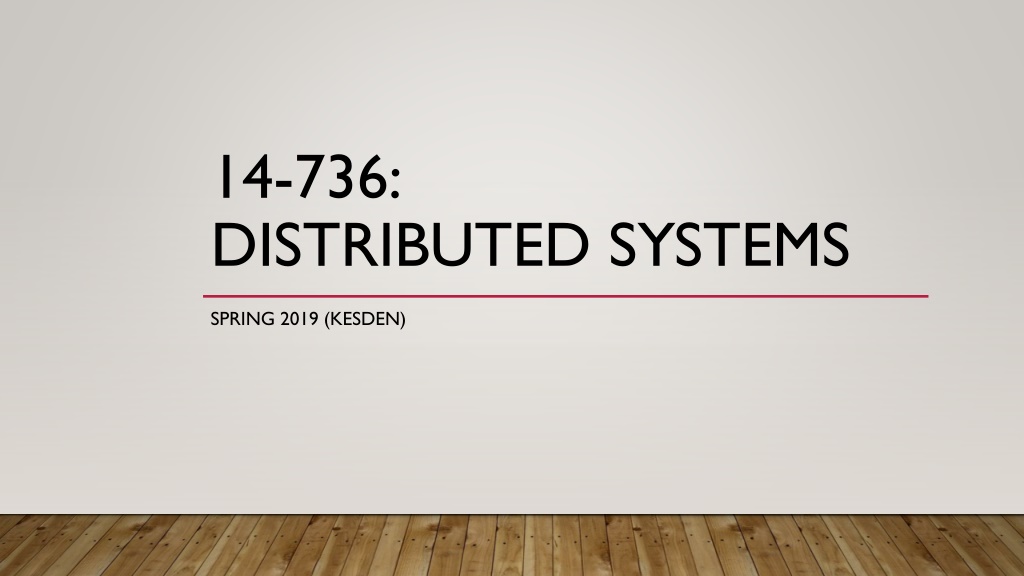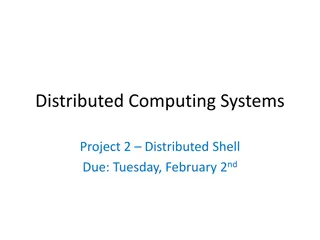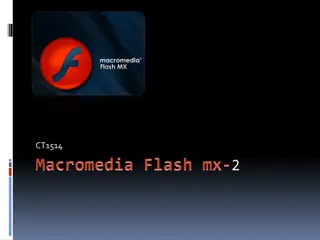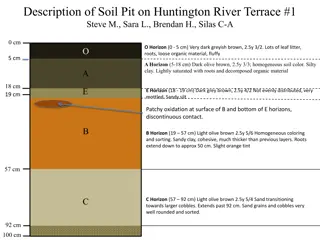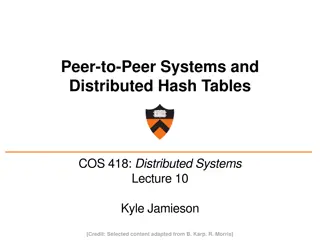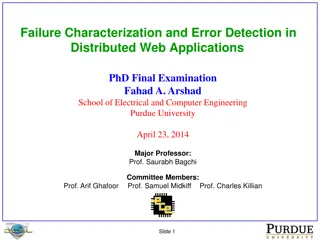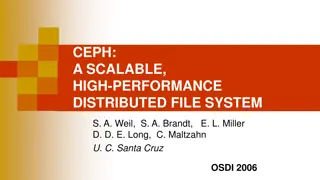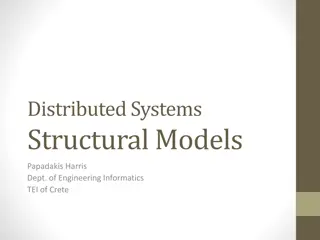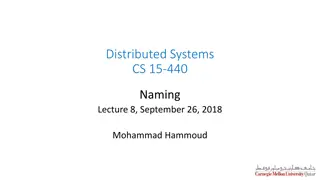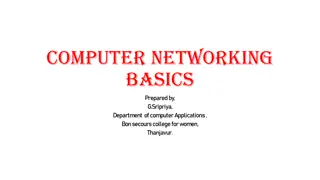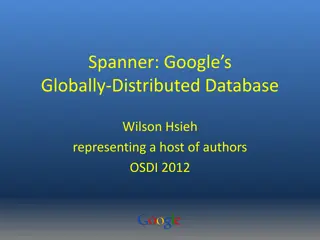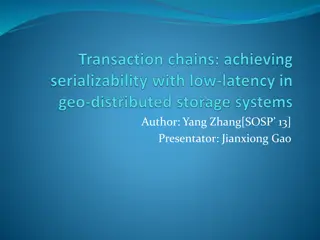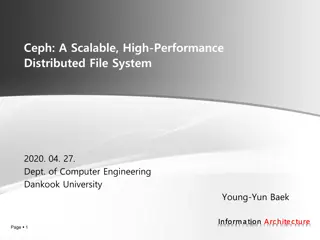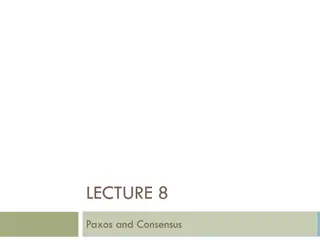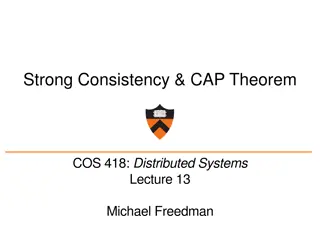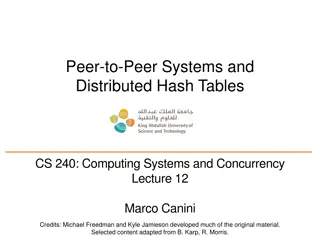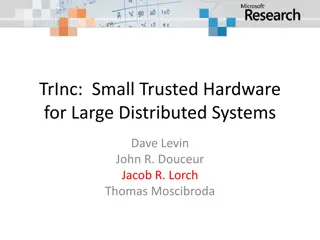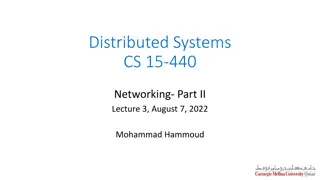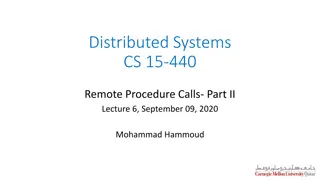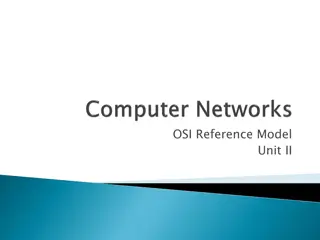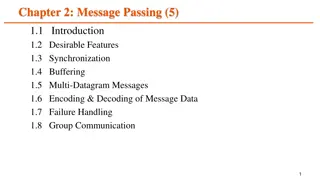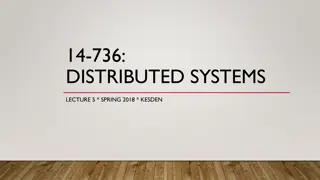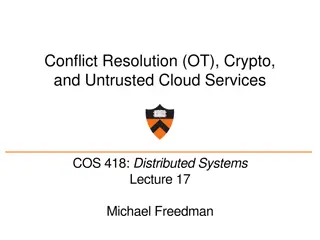Understanding the Layers of Distributed Systems
This content delves into the intricacies of distributed systems, exploring concepts such as establishing communication with applications, managing channels for actual communication, bandwidth versus latency considerations, and the functions of physical, link, and network layers. From the physical layer that deals with the medium of communication to the network layer scaling up for global connectivity, each layer plays a crucial role in enabling seamless communication across interconnected systems.
Download Presentation

Please find below an Image/Link to download the presentation.
The content on the website is provided AS IS for your information and personal use only. It may not be sold, licensed, or shared on other websites without obtaining consent from the author. Download presentation by click this link. If you encounter any issues during the download, it is possible that the publisher has removed the file from their server.
E N D
Presentation Transcript
14-736: DISTRIBUTED SYSTEMS SPRING 2019 (KESDEN)
Application Establish an idiom for communicating with a particular application Transport Establish endpoints useful to a programmer NETWORK REFERENCE MODEL Network Given multiple inter-connected LANs, achieve cross-connectivity, Link Manage the channel to enable actual communication, i.e. establish a LAN Physical Establish a channel with connectivity and signaling
PHYSICAL LAYER: ESTABLISHES THE CHANNEL Medium? Light? Radio frequency? Electrical signals? What color(s) of light? How bright? What RF frequencies? How powerful? What signals represent what values? What shape are the connectors? How far can cables run? Etc. We have a functioning physical layer once we have the ability to send and receive signals
PHYSICAL LAYER: BANDWIDTH VS LATENCY Bandwidth = bits/second. Improved with parallelism or faster clock rate Latency = Function of signal propagation speed Limited by speed of light Major paradigm shift would be needed to make traffic to India or China less latent Latency tends to be limiting at a global scale Speed of light over long distances Bandwidth tends to be limited at local scale, e.g data center How to divide up and recombine messages to utilize parallelism? How to clock faster without losing signal to noise.
LINK LAYER: MANAGES THE CHANNEL When do we start transmitting? When do we stop? When do we start receiving? When do we stop? Who is sending? Who is receiving? How do we know if it is correct? What happens if there is contention for, or collision in, a shared channel? Key contributions: Framing, among others We have a functioning link layer once we can build a functioning LAN of at least two stations.
NETWORK LAYER: SCALING UP Passing messages among multiple networks For scale Of different types (wired, wireless, fiber, infrared, etc) Managed by different domains, etc. Globally meaningful addressing Ability to choose paths among multiple options We have a functioning network layer once we can connect multiple networks, identify hosts among them, and messages can find their way across networks from source to destination.
TRANSPORT LAYER: MEANINGFUL ENDPOINTS Hosts don t communication various aspects of software systems do Consider how many different sessions your Web browser has with servers. Now add for your IM sessions, upgrades-in-progress, music streaming, etc. Endpoints enable the establishment of sessions Classic model is <<IP:port>:<IP:port>> Client: Ephemeral port Host: Well-known port
TRANSPORT LAYER: MEANINGFUL ENDPOINTS, CONT. Character of communication Reliable/session-oriented, e.g. TCP Unreliable/datagram, e.g. UDP Etc. The transport layer exists once we have the ability to establish communication from end- point to end-point with well-understood properties
APPLICATION LAYER: PURPOSEFUL COMMUNICATION Defined by the messaging we, as programs, bake into our applications, shaped by our applications, e.g. client-server interactions, peer-to-peer interactions, etc. E.g. HTTP: PUT, GET, POST, etc E.g DNS: queries, responses, updates, etc. MIME, VOIP protocols, etc. Application protocols exist when applications can communicate
QUICK EVOLUTION OF LANS: SIMPLE LANS Two or more hosts share a common physical medium, e.g. ethernet Physical protocols define hardware Link-layer protocols manage it Point-to-point, e.g. fiberoptic Broadcast, e.g. ethernet
QUICK EVOLUTION OF LANS: WIRED LIMITS Consider ethernet: Multiple stations share a common wire What happens if more than one transmits at the same time? Collision, e.g. corruption Link layer manages collision, e.g. exponential back-off, jamming signals, etc. Wire can only get so long Attenuation, power to drive it, noise, etc. Mess of actually getting the wire through the building, etc. Can only have a certain number of stations Too little network time per each, otherwise Aside: Wireless has similar limits, too.
QUICK EVOLUTION OF LANS: BUS TOPOLOGY Imagine having to snake one wire around the building! https://upload.wikimedia.org/wikipedia/commons/9/9e/Bustopologie.png
QUICK EVOLUTION OF LANS: HUB TOPOLOGY The bus remains an equivalent collision/contention domain, but the wiring gets easier, physically. home runs to wiring closet, etc. Adapted from: https://upload.wikimedia.org/wikipedia/commons/9/9e/Bustopologie.png
QUICK EVOLUTION OF LANS: HUB HIERARCHY Hierarchies can be built, e.g. one hub per Hallway connected to one hub for the floor. But, all buses form a single collision/contention domain.
QUICK EVOLUTION OF LANS: NETWORK SWITCHES Enable connection of input and output port pairs without sharing a single common channel Crossbar switch: Mess of switched connections Input and output buffering with shared memory and control Etc Learning Pay attention when host sends to learn which port it is on, then direct messages to that host only to that port Flood all ports only when destination unknown. Enables larger networks Terminology note: A bridge is a simple switch with only two ports.
QUICK EVOLUTION OF LANS: LIMITS Even with switching, there is a limit to the size of a LAN In the worst case, a host which is not known, the entire LAN is still a single contention/collision domain If a host hasn t yet sent, or hasn t sent recently enough to be cached, flooding will be needed The flooding can, in the worst case, flood every port on every switch There obviously is no way to know the location of every host on the Internet And, of course, networks use different technologies, are managed by different domains, etc.
THE NETWORK LAYER Hierarchical addressing Traditional IPv4 addresses: 32-bits: Network# + Host Number IPv6 addresses: 128-bits and more structured Host number translated to LAN station ID, e.g by ARP between IPv4 and 802.11 Routing selects path to take from one network to another, often on a hop-by-hop basis Does this packet belong on one of my LANs? If so ARP and deliver If not, send upstream (or to a peer, or ) This provides for an order of magnitude more hosts
THE NETWORK LAYER: IP ADDRESS ASSIGNMENT Old school: Go to system administrator and trade MAC address for IP address Today: DHCP server automates this. Broadcast of request with MAC is answered with assigned IP Assigned IP is leased and needs to be renewed Assigned IP can be from dynamic pool Assigned IP can also be according to a pre-configured rule, such as to give a server a well- known address DHCP can also communicate other configuration information
DOMAIN NAME SYSTEM Old school Let The Keeper of All Things know about a hostname:IP assignment in your organization The Keeper updates a hosts text file with the information Periodically download this file to keep your system up to date Obvious scalability problems, but /etc/hosts still exists vestigially and for special cases Today Domain Name System (DNS) is a distributed data base that delegates assignments for information to the responsible domains and can direct queries to the servers associated with those domains. Uses caching for efficiency. We ll talk about it later in detail
TRANSPORT LAYER: USER DATAGRAM PROTOCOL (UDP) Reminder: Port numbers in addition to IP addresses Best effort = Unreliable Messages can be lost or reordered Message corruption is assumed to be detected at the link layer Message oriented. Max message size Simple Used for timely updates, e.g. send audio or video for teleconferencing
TRANSPORT LAYER: RELIABLE PROTOCOLS Keeps trying to send data until it succeeds or times out Used acknowledgements to determine that it does not need to resent Buffers to ensure in-order delivery, which allows head-of-line blocking Messages are assumed to be correct or undelivered via checksums at link layer Byzantine Failures are possible, occur commonly at Internet scale, but infrequent enough to be (mostly) ignored. Maybe. Can t guarantee delivery. At best can trade timeliness for delivery
TRANSPORT LAYER: STOP-AND-WAIT PROTOCOLS Send a message. Wait one fully network latency for it to get to the recipient. Wait for the recipient to process it. Wait another full network latency to send back the acknowledgement In one round-trip time (RTT), only one message is sent. RTT sec * bits/sec = total bits we can send in that time. Size of message is what we actually sent. Rest of time is wasted waiting.
TRANSPORT LAYER: SLIDING WINDOW Buffer enough data on sender to keep sending for the entire RTT. Treat sending buffer as circular: As ACKs come back, slide window to buffer new data, releasing old data and keep sending. If ACK doesn t come back in time, resend data. Head-of-line blocking is possible Keep buffer an receiver in sync with sender to buffer, releasing segments up the stack in order. Requires segments, segment numbers
TRANSPORT LAYER: SLIDING WINDOW Acknowledged packets Packets not acknowledged yet LFS seq. numbers LAR LAR (last ACK received) LFS (last frame sent)
TRANSPORT LAYER: SLIDING WINDOW, CONT. Sender Receiver Next expected Max acceptable Max ACK received Next seqnum Sender window Receiver window Credit: Hui Zhang Sent & Acked Sent Not Acked Received & Acked Acceptable Packet OK to Send Not Usable Not Usable
TRANSPORT LAYER: TRANSMISSION CONTROL PROTOCOL (TCP) Reminder: Port numbers in addition to IP addresses Used for transmissions that need to be correct, but not timely Streaming audio or video, e.g. recorded movies Bulk data transfer, e.g. uploads or downloads Requires overhead of establishing a session to maintain shared state between sender and receiver to coordinate. Different schemes for ACKs Delayed ACKs, Cumulative ACKs, Selective ACKs
TRANSPORT LAYER: TRANSMISSION CONTROL PROTOCOL (TCP) Congestion Control Packet loss can be due to many types of failure, including congestion If congestion, desire is to slow down. Slowing down can be achieved by shrinking window, which leaves network time unused TCP has different strategies it can use to determine when to slow down and how to speed back up. 3-Way Handshake: SYN, SYN-ACK, ACK-SYN Establishes session, negotiates window sizes and other options, e.g. SACK, window sizes, etc.
